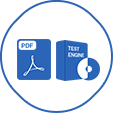Last Update 5 hours ago Total Questions : 228
The QMS ISO 9001:2015 Lead Auditor Exam content is now fully updated, with all current exam questions added 5 hours ago. Deciding to include ISO-9001-Lead-Auditor practice exam questions in your study plan goes far beyond basic test preparation.
You'll find that our ISO-9001-Lead-Auditor exam questions frequently feature detailed scenarios and practical problem-solving exercises that directly mirror industry challenges. Engaging with these ISO-9001-Lead-Auditor sample sets allows you to effectively manage your time and pace yourself, giving you the ability to finish any QMS ISO 9001:2015 Lead Auditor Exam practice test comfortably within the allotted time.
You are conducting an ISO 9001 audit of a Materials Recycling Facility (MRF). The organisation processes
waste plastics into raw materials for plastic bottle manufacturers. You reach the manual picking line where operators are removing contaminant materials from incoming products, such as plastic bags, plastic film and badly contaminated items that would compromise the recycling process. You interview the line supervisor.
You: "Why are these plastic items being rejected at this stage?"
Auditee: "They do not meet our processing standards."
You: "What is the reason for that?"
Auditee: "These items are likely to damage the machinery down the line. They can also compromise our
quality standards. We need to protect our reputation for good quality output materials."
You: "What happens to the rejected items?"
Auditee: "Some get melted down in another process later on and some are disposed of as waste products that cannot be recycled."
You: "What happens to the waste products?"
Auditee: "I'm not sure. I suppose they go to landfill."
Which two. of the following actions would you take to investigate further?
What does the application of the process approach in a QMS enable?
What are the objectives of the Stage 2 audit?
A person who provides specific knowledge or expertise to the audit team during the audit is known as a/an:
According to ISO 19011, what two activities take place during the conduct of a audit follow-up?
Consultancy ABC, which is a subsidiary of a certification body called ABC-CERT, provided consultancy services regarding the implementation of a QMS based on ISO 9001 to an organization. Considering this, can ABC-CERT provide certification services to the organization which obtained consultancy services from Consultancy ABC?
The following actions need to be carried out during a third-party audit planning stage. Which two actions correspond to the individual(s) managing the audit program before the involvement of the audit team leader’

